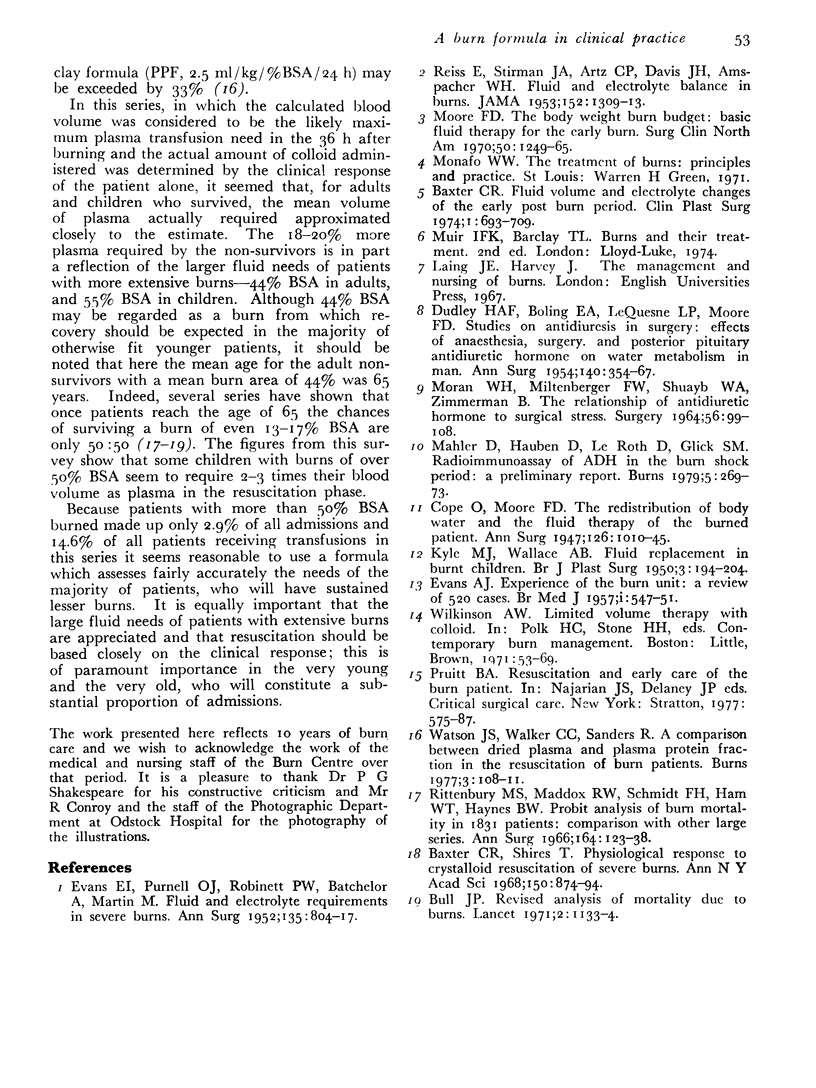Abstract
In a retrospective review of the 10-year period 1969-78 the intravenous plasma loads given to patients admitted to one burn centre were studied and compared with the volumes predicted by the formula used at that centre. Of 1728 patients admitted 342 (19.8%) received intravenous resuscitation with plasma. The formula appeared to be a good empirical guide to transfusion needs in the 36 h after burning. Patients with burns in excess of 45% body surface area (BSA), and particularly children, were likely to require more fluid than that indicated by the formula estimate. However, as burns in excess of 50% BSA are uncommon (50/1728 admissions) it seems reasonable to use a formula which is a guide to the probable needs of most patients while accepting the clinical response as the best means of assessing the actual fluid need of each patient, especially those with extensive injury.
Full text
PDF



Selected References
These references are in PubMed. This may not be the complete list of references from this article.
- Baxter C. R. Fluid volume and electrolyte changes of the early postburn period. Clin Plast Surg. 1974 Oct;1(4):693–703. [PubMed] [Google Scholar]
- Cope O., Moore F. D. The Redistribution of Body Water and the Fluid Therapy of the Burned Patient. Ann Surg. 1947 Dec;126(6):1010–1045. doi: 10.1097/00000658-194712000-00013. [DOI] [PMC free article] [PubMed] [Google Scholar]
- DUDLEY H. F., BOLING E. A., LEQUESNE L. P., MOORE F. D. Studies on antidiuresis in surgery: effects of anesthesia, surgery and posterior pituitary antidiuretic hormone on water metabolism in man. Ann Surg. 1954 Sep;140(3):354–367. doi: 10.1097/00000658-195409000-00012. [DOI] [PMC free article] [PubMed] [Google Scholar]
- Dudley F. J., Fox R. A., Sherlock S. Relationship of hepatitis-associated antigen (H.A.A.) to acute and chronic liver injury. Lancet. 1971 Jul 3;2(7714):1–3. doi: 10.1016/s0140-6736(71)90001-8. [DOI] [PubMed] [Google Scholar]
- EVANS A. J. Experience of the burns unit; a review of 520 cases. Br Med J. 1957 Mar 9;1(5018):547–551. doi: 10.1136/bmj.1.5018.547. [DOI] [PMC free article] [PubMed] [Google Scholar]
- EVANS E. I., PURNELL O. J., ROBINETT P. W., BATCHELOR A., MARTIN M. Fluid and electrolyte requirements in severe burns. Ann Surg. 1952 Jun;135(6):804–817. doi: 10.1097/00000658-195206000-00006. [DOI] [PMC free article] [PubMed] [Google Scholar]
- KYLE M. J., WALLACE A. B. Fluid replacement in burnt children. Br J Plast Surg. 1950 Oct;3(3):194–204. doi: 10.1016/s0007-1226(50)80030-9. [DOI] [PubMed] [Google Scholar]
- MORAN W. H., Jr, MILTENBERGER F. W., SHUAYB W. A., ZIMMERMANN B. THE RELATIONSHIP OF ANTIDIURETIC HORMONE SECRETION TO SURGICAL STRESS. Surgery. 1964 Jul;56:99–108. [PubMed] [Google Scholar]
- Moore F. D. The body-weight burn budget. Basic fluid therapy for the early burn. Surg Clin North Am. 1970 Dec;50(6):1249–1265. doi: 10.1016/s0039-6109(16)39285-4. [DOI] [PubMed] [Google Scholar]
- REISS E., STIRMANN J. A., ARTZ C. P., DAVIS J. H., AMSPACHER W. H. Fluid and electrolyte balance in burns. J Am Med Assoc. 1953 Aug 1;152(14):1309–1313. doi: 10.1001/jama.1953.03690140017004. [DOI] [PubMed] [Google Scholar]
- Rittenbury M. S., Maddox R. W., Schmidt F. H., Ham W. T., Jr, Haynes B. W., Jr Probit analysis of burn mortality in 1,831 patients: comparison with other large series. Ann Surg. 1966 Jul;164(1):123–138. doi: 10.1097/00000658-196607000-00014. [DOI] [PMC free article] [PubMed] [Google Scholar]


